Manchester City: Positional play analysis
The first season in Manchester under Pep Guardiola has been a little inconsistent, although the clear signs of improvements are steadily visible. With the arrival of Guardiola a whole adaptation process started for the team, which was basically and most importantly the presentation and implementation of the Positional Play. Here TP in August has already previewed the issues City has had in the previous season, and the possible changes that Guardiola may bring to Manchester City.
Early stages of the season
They have started the season in 4-3-3 formation, with using the false full-back approach, which Guardiola has already used at Bayern with Lahm and Alaba.
This approach resulted in creating more and isolated 1v1 situations for Nolito and Sterling on the flanks, especially the latter could create huge advantages of that. In possession it formed a 2-3-5/-2-3-2-3 shape, with narrow full-backs in the halfspaces, and wide wingers at the flanks, although understandably their individual and collective movements and orientations was a bit far from the orthodox positional play requriements – zonal attack/responsibility. Nevertheless the 2 central-midfielders -mostly De Bruyne and Silva- were often able to create a decisional crisis in the opposing defense, as the defenders were not able to react and adapt to their positioning in between the lines –in the halfspaces-, therefore they could often offer an easy option in between the lines. Also, the 2 full-backs often moved into higher positions, which in one hand created and overload at the ball’s zone, created more options in depth, and kept –forced- the opponent’s second-line narrower, which opened up spaces next to the sidelines for the wingers. Although on the other hand it had a negative effect of leaving the players from City’s first-line without proper options as the spatial distribution wasn’t optimal to maintain the constant horizontal circulation in order to move the oppositional shape and open up spaces or passing lanes.
This movement created a 3-2-2-3 shape in possession, with the defensive midfielder dropping into the first line, in between the centre-backs, which on fact could often cause issues for the oppositional side and gave a structural flexibility in the middle third. Occasionally they have used a 2-3-5/2-3-2-3 with deeper and wider full-backs, but that was mostly used in the second half of the season.
Issues
In a lot of cases they couldn’t control the tempo of the game well both individually and collectively. Mostly the two centre-backs and the defensive-midfielder failed to perceive if the collective structure is optimal –every player is occupying their respected zones- and make a decision according to that, therefore they often accelerated the tempo, even when it wasn’t functional.
The two central-midfielder, whom basic positioning is in between the lines often dropped in front of the oppositional second-line, which in fact slowed down the progression through space, as the structural adaptation was missing – meaning there was no one who took their positions in between the lines.
When the ball reached a zone in between the lines, the progression from that wasn’t ideal. The receivers often just played a simple back pass, instead of turning towards the oppositional goal, even when they had the opportunity for that.
Serious issues in building from the back under pressure, which mainly came from the inability of perceiving and finding the free-man and know how to progress through that. In the first months the full-backs took a more central role under pressure and as the wingers often followed them to the inside, it opened up the direct passing lane towards the wingers and also as an oppositional central-midfielder often stepped out to close down the defensive-midfielder –Fernandinho-, the central-midfielders were in a 2v1 situation against the remainder central-midfielder. With opening up the direct access towards the wingers, they could gain more space in depth, however with having a higher emphasis on the flanks they could have been isolated easier. The same issue arose in the connections with the central-midfielders: the full-backs central positioning tightened the second-line and also left the centre-backs without a connection at the sidelines, resulting no access towards the central-midfielders from these build-up movements.
Tons of times when they were able to create a positional or situational superiority from their structure and movements, they couldn’t exploit these because of technical errors, coming from mostly orientation issues –not optimal body-posture, passing onto the wrong foot in many cases.
Whilst in possession, there were too much movements at the back –from the back 5 players-, as they didn’t stick to their positions, which resulted inviting the pressure –a basic positional play principle-, but lacked the structure to overcome it, which made them vulnerable against the press.
From a strategical point of view the weakness of these movements were that most often the full-backs became the free-man –instead of the central-midfielders for example-, and they weren’t able to progress from these situations in an effective manner.
A situation to summarize the early issues: as Fernandinho finds Iheanacho –who drops in the centre to provide a vertical option- he is left without any kind of support. The centre isn’t occupied to provide an option in between the first-second line of the oppositional shape, also De Bruyne’s positioning is an issue, as he moves towards the ball, not away from it to increase the potential space, plus even the Sterling-Nolito-Silva trio don’t try to manipulate the last line, therefore the CB may step out with Iheanacho without causing any danger.
In many cases when the centre-backs started to drive forward with the ball, the defensive-midfielder –Fernandinho- automatically moved back to take the teammate’s position, didn’t even try to stay and offer a short option or to manipulate the oppositional first line, with creating a decisional-crisis –until when to cover the defensive-midfielder and go out to press etc.
Vulnerability against pressure: at the moment when Stones passes the ball back, Otamendi should already be in position to help the progression, but not being there gives just enough time for the opponent to force out a long ball from Bravo –as he has no immediate option to advance. Also, the full-backs occupy a higher positioning, although with this positioning they weakened the offensive connections –especially with the centre-backs-, and were easier to be closed down from a defensive point of view.
Another issue was at the build-up phase –under pressure- that the centre-backs often occupied a too wide position, nearly hugging the sidelines, but with this they have decreased their own possible space and time on the ball, which led to significantly worse options. E.g. it forced the full-backs to a higher position, increasing the distances in between the player. This caused that the centre-backs – full-backs connection wasn’t ideal at the build-up phase, therefore even the defensive-midfielder(s) were not accessible for the centre-backs.
The 3-2 system at the back
In the first half of the season they often used a 3-2 positioning at the back –with 3 centre-backs and 2 defensive-midfielders. A possible advantage of using 2 defensive-midfielders is a better way of manipulating the oppositional second-line, and also this system looked a better fit for Gundogan –alongside Fernandinho-, because in this structure he was able to play facing the oppositional goal, whilst Silva and De Bruyne could stay in between the lines.
As Everton’s first-line is staying higher it’s much easier to manipulate the second-line, here Gundogan could immediately rotate to the ball-far halfspace to KDB, who is in positional superiority and is able to turn towards the oppositional goal. Also important to mention the occasional false-nine movement from the strikers –here Iheanacho-, as his dropping movement forces the centre of the oppositional second line to defend narrower in order to cover the centre, which opens up more space for KDB to receive and turn at the ball-far halfspace.
In the 3-2 the 2 defensive-midfielders took a higher position, occupying the space in between the oppositional first- and second line, therefore the 3 centre-backs had the responsibility of the circulation at the back. With this system they could open up space for the centre-backs to drive forward, although they have often been left without options, especially in a horizontal sense. If they couldn’t find a vertical option, then they didn’t have an ‘escape-route’ towards the flanks to maintain possession. Thus, diagonal balls towards the ball-far side got a bigger emphasis, with direct switches towards the ball-far wingers –including the ‘fake’ runs from the central-midfielders.
A possible advantage of this positioning is that with having 2 defensive-midfielders in between the first- and second line provides a better structure to manipulate the second line’s behavior. Especially Gundogan excelled at this, who purposefully moved towards the centre from the halfspaces to force the oppositional first line to cover him, thus opening up space for the centre-backs, plus even manipulates the oppositional central-midfielder to step higher towards him, which in fact opens up space in between the lines or creates an open man at the flanks.
Another important movement in this system was that when the 2 defensive-midfielder could face the oppositional goal with the ball then the side-backs –in the 3 defender system- took a wider position to give a horizontal option, plus to force the oppositional winger into a wider positioning.
Inviting the pressure and escaping from it against Liverpool at the last day of the year. Using wall passes at the back to invite the press, then finding the free-man –De Bruyne-, who is in positional superiority.
At this point the composure at the back got much better, players started to play from the respected zones and positions, passing onto the right foot with a more conscious purpose, so the receiving player was able to handle the pressure. With having 2 defensive-midfielders the free-man often became one of the central-midfielders in between the lines. The 3-2 functioned more effectively, when one of the defensive-midfielders took a wider position in order to pull an oppositional central-midfielder out, thus forcing the oppositional second line to adjust with a shift towards the ball’s zone more. This movement cleverly opened up space on the ball-far side. Although this shape still arose some problems: often the cooperation between the defensive-midfielders wasn’t effective, plus the movements to functionally manipulate the oppositional second line were missing. The centre-backs got occasionally isolated at the wider zones, because of the structural and connection issue, especially towards the flanks, as they didn’t have a safe escape route after driving forward. If the wing-backs/wingers wanted to provide a better connection they had to drop too deep, which prevented the collective task to advance the ball, also without having an immediate option at the flanks, they could have been closed down easier with simple tight marking –preventing them to turn towards the oppositional goal. If they occupied a higher position, then the centre-backs didn’t have the direct connection from the halfspaces or even if they had, the defensive side could adapt to it easily.
The occupation from the central-midfielders in between the lines –in the halfspaces basically- creates a decisional crisis in the defenders: if a winger decides to defend wider, it may create easier access to the central-midfielder with a clearer passing lane, if he defends narrower, then it opens up the direct passing lane towards the flanks for the winger, who has to adapt his positioning in depth constantly according to the oppositional winger’s positioning to help the progression of the ball. Also, the central-midfielder may make a vertical run to pull the whole defensive shape at the ball’s zone to a deeper positioning, which opens up space for the defensive-midfielders and the full-backs, as the oppositional shape is forced to defend deeper.
As I wrote before the issue of being isolated at the flanks often arose in the 3-2 structure. Here is an elegant solution against that, the key movement is from KDB to create space diagonally, where Yaya Touré is able to step up, avoiding the oppositional first line to press and isolate the possession at the sidelines.
A slight issue with this 3-2 positioning is that it doesn’t provide enough horizontal stretch to move the opponent in the middle third. It may open up central spaces in a better way, although the ball cannot be moved horizontally with such flexibility as in a 2-3 formation. Therefore Silva and KDB often drifted into a wider position to create a better horizontal connection.
Movements to create space at the wider areas
An important movement in their positional play is the usage of the ‘fake’ vertical run from Silva and KDB. They make their runs in between the oppositional full-back and centre-back, which on one hand gives a possible through ball option behind the last line, on the other hand it tightens the oppositional last line –forcing the full-back to cover him and be narrower-, which opens up more space on the wider areas for the wingers for a possible direct switch.
This movement occasionally was able to manipulate even 3 defender, which opened up space for the winger, to create a 1v1 with situational and dynamical superiority- also, as the side-backs -Stones- moved wider they were able to keep the oppositional winger in position to open up the direct channel towards the wingers -Sane.
In the evolution of City’s positional play throughout the season a key factor was the central-midfielders positioning: with their positioning in between the lines they were not only able to manipulate the oppositional second line, but the last line as well. They were trying to maintain an equal distance from both lines –defender- forcing them to a crisis, on whose task is to cover him. With the vertical runs or space increasing movements they were able to pull the second line with themselves, with creating just enough separation that the last line has to adjust to it as well – usually a centre-back shifted there to cover the run. As a result of this space opened up at other zones of the pitch, usually at the flanks for the wingers, but occasionally at the centre as well for the dropping centre-forward.
Using the N#9 to rotate
Analyzing City’s in possession strategy, we can all see the huge emphasis on getting the ball towards the central-midfielders in between the lines. As a result of this the opponents tried tons of different ways to neutralize this strategy, with more or less success. The common similarity in these approaches –man-marking Silva and KDB, narrower defending from the wingers etc.- was that it could still stretch the oppositional second line with opening central spaces and passing lanes towards the N9 position. It was mostly successful from the central 3 channels, especially when the centre-backs were the ball carrier. Because of the staggering at the back, the defensive-midfielder could often force the centre of the oppositional second line to step out, opening up the passing lane diagonally towards the forward. Besides the striker’s dropping movements were not always being closed down by a centre-back –as the wingers occupied a high positioning, they were immediately able to exploit the space with a diagonal run, if the centre-back decides to step out with the striker-, resulting the oppositional central-midfielder being doubled by the striker and the central-midfielder –decisional crisis.
In reaction to this defensive approach the central-midfielders often moved towards the outside areas with ‘fake’ move a to manipulate the defender –like De Bruyne here-, to open up the direct passing lane through the central channel. This is a typical City action, at the end the goal is still to rotate towards Silva or De Bruyne into positional superiority, then trying to create a dynamical one with the wingers –who hug the touchline as long as they can, which offers them enough separation to create a dynamical superiority.
In the latter stages of the season they created another kind of advantage of this defensive approach, mainly with Fernandinho at the right-back position. He mostly stayed in the right halfspace and from here he was able to dictate the progression of the ball better, and as the oppositional winger and central-midfielder were trying to block the access to Silva and KDB, it increased the space and time on the ball for him. When having the ball diagonal spaces often opened up, as the oppositional central-midfielder was trying to close down the space in between the lines, therefore Fernandinho was able to cut inside diagonally many times –lot of long diagonal balls from here towards the ball-far side, using the central-midfielders’ ‘fake’ run to open up space for the wingers.
Outward movements from the central-midfielders
As I wrote earlier City had to adapt to the defensive approaches focusing on neutralizing the connection towards to the central-midfielders, therefore Silva and KDB occasionally moved towards the flanks from the halfspaces with a simple outward movement –this mainly happened, whilst the full-backs or the centre-backs were the ball carrier. This forced the oppositional central-midfielder to decide: if he moves out to follow him, then he risks opening up space in the halfspace for a vertical penetration, although if he doesn’t follow him, then the central-midfielder is able to receive and turn towards the oppositional goal.
In connection with this movement the wingers also had an important function, which relates strongly to screening in basketball: when perceiving the movement from the central-midfielder, they tried to increase the space for the teammate, and also to keep the oppositional full-back in position –mostly with vertical movements. When the central-midfielder made this movement they did even like to sign the block for the wingers with their hands to open up space for themselves.
When the wingers and -central-midfielder- saw that the oppositional central-midfielder is not following this movement, they tried to keep the full-back in position, although when the central-midfielder decided to follow it, they immediately tried to moved inwards to exploit the generated passing lane.
The 2-3 structure & rotation at the back
Using either structure at the back, the key is to have flexibility in order to be able to adapt to different game situations. Therefore the 2-3 may easily turn into a 3-2 and vice-versa. Usually the first happened, if the 2-3 structure weren’t able to penetrate in an effective way, then the defensive-midfielder dropped in between the centre-backs and the full-backs moved inside to occupy the central zones. Although the strategic disadvantage was that in this structure the free-man often became the 2 full-backs, because of the central-midfielder orientated defending from the opponents. Even with being in a positional superiority the full-backs weren’t able to exploit this as well as a central-midfielder or defensive-midfielder could have. Still, being able to flexibly change between the two had the advantage of causing adaptation problems for the oppositional side.
The 2-3 with flexible full-backs although were tougher to press, because of the better connections it provides at the back. Tons of times they were using simple wall passes to invite pressure and open up spaces at the wider areas. Lot of times these wall passes were being used in between the oppositional first and second line to manipulate the latter, although the orientation of immediately exploiting the open space vertically was missing, as these wall passes were much rather used gather the opponent around the ball –tightening the second line- to open up spaces at the back for a horizontal switch.
Overloads
Basically, the players tried to act within their respected zones, but Silva and KDB often moved to the other side, to create an overload there with each other. This connection often resulted successful penetration, because of the better manipulation it allows against the oppositional second line to create a free-man in between the lines. It mainly happened, when they were in a losing position, and was often helpful for a better penetration, but hurt the collective structure, as it didn’t allow the quick switch to the other side to move the opponent.
Dynamism at the wider zones
With having dynamic wingers –Sane, Sterling- the emphasis at the wider zones was understandably to create a dynamical superiority either with exploiting the individual speed of the faster players or with having dynamical movements at the flanks. The former often happened because of the constant width by the wingers, which allowed them create enough separation from the full-backs to create a dynamical advantage –mostly when the central-midfielders were able to receive and turn in between the lines, then it was the trigger to get behind the oppositional last line using the wingers. When the ball arrived to the flanks without having a dynamical or situational superiority they used different movements to create an advantage, mostly by using overlapping and underlapping runs or making various rotations between the full-back, central-midfielder and the winger.
The wingers in depth occupation is also a key element in City’s positional play. Fundamentally they attack the last line, but it may vary according to the situation: for example if the ball is at the centre-back who is driving forward it’s functional to occupy the same depth as the last line, because in this way he is able to manipulate the oppositional last line’s behavior. If the oppositional centre-back decides to step out of the line to close down the central-midfielder in between the lines, then the winger is immediately in position to exploit the generated space with a diagonal run.
The wingers positioning relates with the full-backs positioning on the flanks. In the last months City used wider and deeper full-backs, which clearly had it’s own advantages and disadvantages. A possible advantage of the deeper full-backs is that the oppositional winger can’t really have an optimal access to him, because if he moves out of the shape too much, then it opens up the direct passing lane towards the winger and creates a better access towards the central-midfielder as well. Also, this deeper positioning may be a better way to invite more pressure from the second line, though at the same time holds the risk of being isolated at the wider areas, if a route out of the press is not assured.
Key players
Obviously the team’s key players were Silva and KDB mainly, who gave the basis of a balanced system. Without them City had serious issues in almost every phase of their positional play, as they didn’t have the personnel to replace these key players -being able to receive and turn in smaller areas. Therefore Pep often tried different structures and specific roles, like Navas or Kolarov being a lone wing-back on the flanks, or using Touré and Fernandinho to occupy the space between the lines at the central-midfielder position, but they lacked the abilities to effectively function in these roles.
At first Aguero lacked the functional movements required for positional play, although in time his movements and positional consciousness did clearly develop. For example in the early stages he made lot of dropping movements without clear purposes -just to had some touches on the ball-, which has had a negative effect on the collective structure. With the introduction of Gabriel Jesus he got a rival for this position, as Jesus’ participation in the combination play was better and more effective.
For months the biggest issue was to find the ideal player for the defensive-midfielder position. At first Fernandinho got the chance to play in this position, although seeing the lack of control at the back Pep changed to the 3-2 structure, with putting Gundogan next to Fernandinho. This structure looked better for a while, although with Gundogan’s injury the issues arose again. It was when Pep finally put Yaya Touré into the team, at first in the 3-2, then in the 2-3 structure. Although as the 2-3 allows only one defensive-midfielder, therefore Pep had to do something with Fernandinho: the solution was to put him into the full-back position, from where he is flexibly able to participate in the circulation of the ball.
Manipulating the man-orientation
At the beginning of the season they’ve got huge issues against man-oriented approaches, as they couldn’t have the adjustments to that. As a result of the man-orientation a centre-back often left open, although collectively they couldn’t advance through that without having a clear plan how to exploit that and also even the centre-backs fell into the trap of having tons of spaces in front of them, but as they couldn’t find vertical options, it resulted with forced long balls –as the centre-backs didn’t have the necessary escaping option, and they tended to drive forward too much. In time, the movements got better, as they used the man-oriented approach to open up the direct access from the central zones towards the wingers.
An example of manipulating the man-orientation to create a situational superiority. As Silva perceives that he is being man-marked, he makes a blind-sided movement inwards, which opens up the direct passing lane towards Sané.
Offering an escape route for the wider areas
An important aspect of the positional structure is to allow the specific needs and goals for a given team. As in positional play a basic goal is to ‘move the opponent’ the structure should be organized in a way to make it possible. Speaking generally one of the biggest issues that must be avoided whilst having the ball is to be isolated individually and collectively. That’s most likely to happen at the wider areas of the pitch, where the number of attacking options could be limited the most efficiently from a defensive point of view.
At the latter stages of the season City used a 2-3-2-3 (2-3-5) structure in possession, which is an optimal one to offer an escape route, when the ball is at the wider areas.
First of all both centre-backs should provide a depth option for the ball carrier to make a back pass available. The ball near centre-back should move towards the ball –even into the flanks-, whilst increase the space in depth, to create a separation from the first line, who is in a decisional crisis about which centre-back to cover. The ball-far centre-back should be ready to make the direct switch available –with a blind-sided movement-, or to offer an affordable passing option for the ball near centre-back to help the progression of the ball horizontally –important from the ball carrier to read the first line’s defensive behavior properly. A defensive-midfielder’s role is to offer an option in between the oppositional first- and second line, which creates a free-man at the back –a centre-back. Even if an opponent defends for example in a 4-4-2, the defensive-midfielder’s positioning divides the first line, as the ball-far forward should move to cover him, because if the second line wants to cover him, then it creates an easier access to the players in between the lines for the ball possession side. In a situation like above, a defensive-midfielder may be used for a simple wall pass, to reduce the oppositional cover of the first line, making a back pass easier and less risky. Important to mention the ball-far full-back’s behavior as well, who makes a movement inwards to the halfspace, to create a better connection with the ball-far centre-back –and also gives cover in case of a ball loss for a defensive transition. He may also give an option for the ball-far centre-back in case of a defensive pressing movement –leading with the ball-far winger-, even at the halfspace or at the central channel. Also from the halfspace he has a direct connection with the ball-far winger, therefore the structure not even allows moving the opponent horizontally, but vertically as well.
Positioning in between the lines
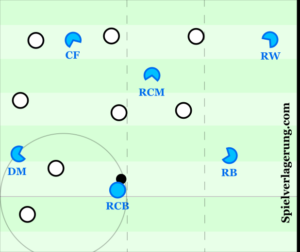 There are several ways for the positioning in between the lines, in City’s system the players –the central-midfielders- basically tried to occupy an equal distance, sometimes closer to the second line, then closer to the last line –varies, according to situation. With holding an equal distance it creates an uncertainty in the oppositional defense on how to adapt to that –from which player from which line to follow him if needed etc. For example if the central-midfielder stays closer to the last line and the forward decides to drop, then it forces the oppositional centre-back to stay in position as the central-midfielder is immediately able to exploit the open spaces behind the last line –interconnection between the offensive players’ movements. Also, if the central-midfielder is closer to the second line, then the emphasis is on being able to receive and turn in between the lines –as staying further from the last line in order to avoid being marked tightly with man-marking from the back.
There are several ways for the positioning in between the lines, in City’s system the players –the central-midfielders- basically tried to occupy an equal distance, sometimes closer to the second line, then closer to the last line –varies, according to situation. With holding an equal distance it creates an uncertainty in the oppositional defense on how to adapt to that –from which player from which line to follow him if needed etc. For example if the central-midfielder stays closer to the last line and the forward decides to drop, then it forces the oppositional centre-back to stay in position as the central-midfielder is immediately able to exploit the open spaces behind the last line –interconnection between the offensive players’ movements. Also, if the central-midfielder is closer to the second line, then the emphasis is on being able to receive and turn in between the lines –as staying further from the last line in order to avoid being marked tightly with man-marking from the back.
Possible movements depending on the oppositional defensive adjustments. For example, if the central-midfielder tries to cover the RCM in between the lines with his cover shadow, then the CF has to adapt and offer a vertical option at the centre -which may also create an indirect connection towards the DM and the RCM. If the winger decides to defend in a heavily narrow manner, then the RW may drop a bit, to open up the direct passing lane towards himself, helping the progression of the ball diagonally, which also could also create an isolated 1v1 in a situational -and possibly dynamical- advantage. From this equal distance the RCM may manipulate both the second and the last line, and may offer a passing option in several areas. With the distance from the second line he has a better view to read the defensive behavior, therefore able to create a more functional separation into the open spaces. If he is being heavily man-marked he may move towards the centre, to open up a direct access towards the winger. He may also make the outward movement towards the flanks to stretch the second line horizontally and force the oppositional central-midfielder into a decisional crisis, to follow him or not. It mostly happens when both the central-midfielder and winger are covering the access towards him. Last but not least from this positioning he has the option to make vertical runs behind the last line -in between the full-back and centre-back-, which may open up space for the winger at the flanks. This movement happens, when the ball carrier is one of the players at the back. He may also make this movement, when the winger has the ball: if the oppositional winger is defending narrowly and the direct passing lane towards the RW is open. From trying to maintain the equal distance, the separation it creates helps him to create a positional and most importantly a dynamical advantage against the defenders. Depending on the defensive behavior space may open up diagonally inwards for cutting inside or the direct access towards the RCM may be open, which means that he receives the ball in a positional advantage behind the last line.
The vertical runs from the central-midfielders behind the last line gives two basic options for the ball carrier:
- With their runs they are able to pull a defender –central-midfielder- from the second line with themselves, opening up space for dribbling inwards diagonally.
- If this space is blocked by the oppositional full-back with his cover shadow, then try to advance through using the run from the central-midfielders behind the full-back. The key is to read the full-back’s defensive behavior properly.
In City’s positional play approach the emphasis is much rather on creating a free-man in positional superiority in between the lines, who is able to receive and turn towards the oppositional goal, than using lay-offs or faster combinations in between the lines. Occasionally faster combinations may happen if there is space and adequate connection in between the lines, but it’s not the usual pattern.
Centre-backs on the ball
Usually the centre-backs often had the opportunity to drive forward with the balls. As I wrote earlier they’ve got issues with exploiting this, as the centre-backs tended to drive forward too much, isolating themselves from the teammates. When a centre-back drives forward they should be a limit in space to don’t weaken the offensive connections by disrupting the structure itself, in City’s system the limit is approximately the height of the ball near full-back. Therefore when the centre-back drives forward but can’t find a vertical option, he just lays it off for the full-back wide. In that way he can still provide an option for a back pass in case of being pressured. With this space limit he may still help the progression of the ball, as when he drives forward it forces the oppositional shape to defend in a narrower and a deeper manner –as the defending sides try to delay a pressure on the ball in this situation as much as possible, to decrease the available space for the opponent-, which usually opens up more space at the wider areas.
Clearly visible improvements for the end of the first season. A much better understanding and implementation of the positional play principles. As the ball gets to the flanks, to structure must offer an escape route. Whilst having the ball at one side it gathers the opponent there, which opens up space at the ball-far zones for Otamendi, who drives forward, respecting the space limit and uses the players in between the lines to rotate towards Touré, who is in positional superiority in between the first and second line.
Build-up under pressure issues
Mainly the centre-backs didn’t occupy the ideal positions in time, which slowed down and negatively affected the whole build-up process, as the goalkeeper was vulnerable against the press –because of the inappropriate positioning of the centre-backs- and could only afford long passes. Not only the goalkeeper-centre-back, but also the centre-back – full-back connection was a bit dysfunctional, caused by bigger distances between each other, which created inadequate passing angles as well. For example using his cover shadow a winger could easily close down the connection in between the centre-back and the full-back at the earlier stages of the season. The fundamental principle of ‘inviting the press’ is already visible, although because of the positioning issues at the back they were not able to advance through that.
A much better connection now between Otamendi and Clichy, and also both centre-backs are now in a better position to give optimal options for the goalkeeper. Occupying the adequate positions also help in slowing down the press, as it divides the defenders’ attention in a more functional way. Besides the deeper positioning from the full-backs helps the centre-back to occupy a better position –not too wide, next to the sidelines-, which was also a big issue at the early stages. Still, as Touré and KDB moves into the same zone they are not able to advance through the press –whilst the winger’s defending to cover shadow Clichy opened up the direct channel towards KDB.
At the later stages Touré often dropped into a very deep position, which opened up space for the centre-backs –mostly they tried to open up space for Kompany- to drive forward. In these cases the ball-far full-back moved inwards to provide an essential option in the central zones. Also the central-midfielders often dropped deep to provide the centre-backs a vertical option and an indirect connection towards the flanks.
Movements in the attacking third
After breaking through the oppositional second line the aim is to maintain the situational and dynamical superiority, therefore lot of vertical and diagonal runs is being made to achieve that, especially from the central-midfielders –making runs in between the full-back and the centre-back, to divide the attentional focus. On one hand it provides a vertical option behind the last line, plus stretches the last line, and usually it opens up space diagonally. On the other hand if the defensive team reacts with tightening the last line to defend this movement, it opens up space at the wider zones for the wingers, who are now in a dynamical superiority. Also the ‘runners’ make their runs from depth, to create an even bigger dynamical advantage against the defender. With a run from depth it’s possible to force the second line near the ball to adjust their positioning by dropping deeper, which often opens up a direct passing lane a space for the 3rd man.
Conclusion
Throughout the season City has improved clearly to implement the principles of positional play in a more functional way. As it is a complex system, the process to acquire and utilize it adequately requires time, it may be stated that their next season in this aspect is going to get better – as it took 3 season for Pep at Bayern. Although the personal changes are inevitable in some positions, especially at the back to provide an even better stabilization for the system –centre-back, full-backs, central-midfielders are definitely needed. Their biggest issue is still the build-up phase –especially under pressure-, this is the area they must improve the most in the upcoming season.
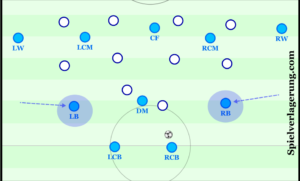

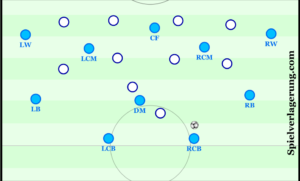
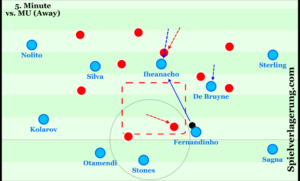



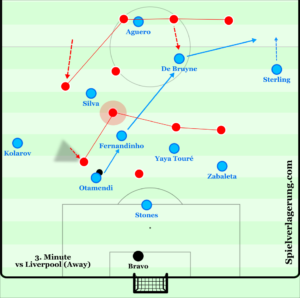

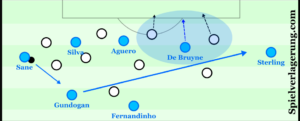
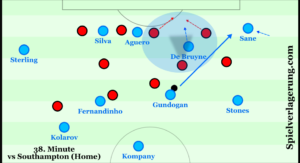



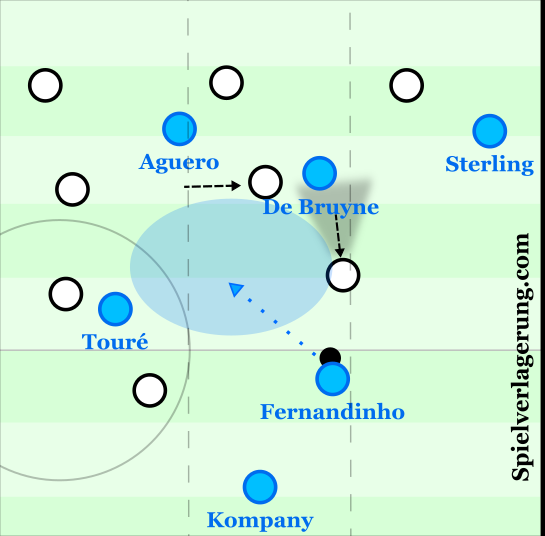

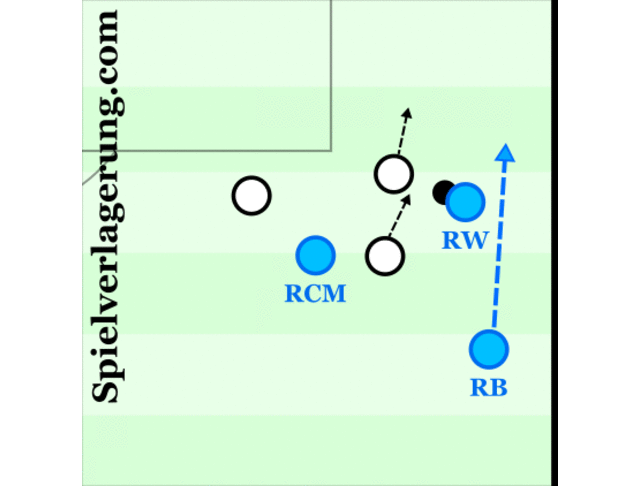
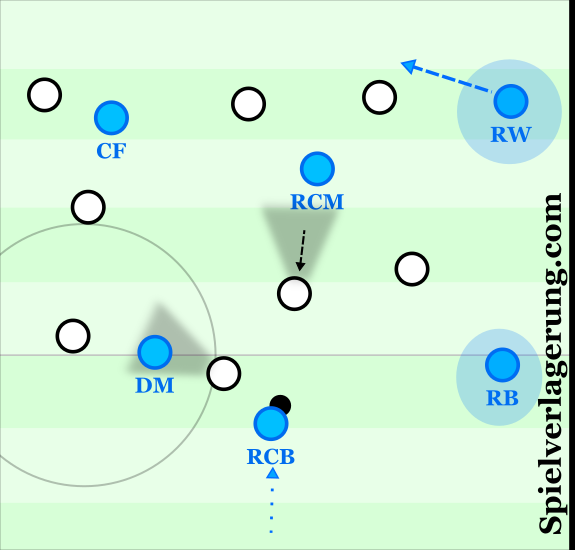
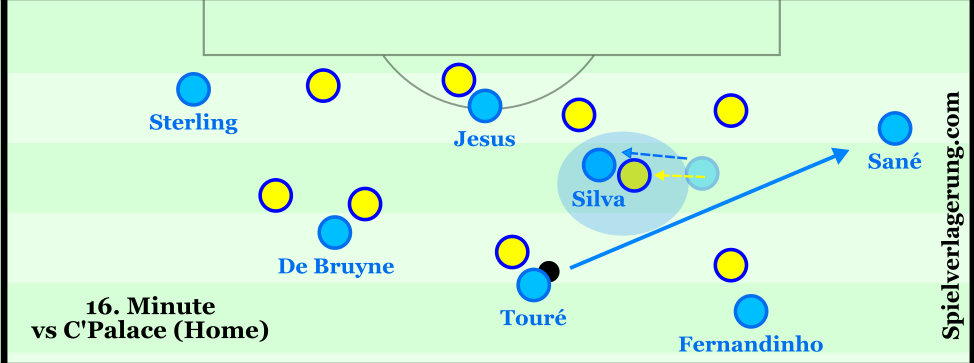
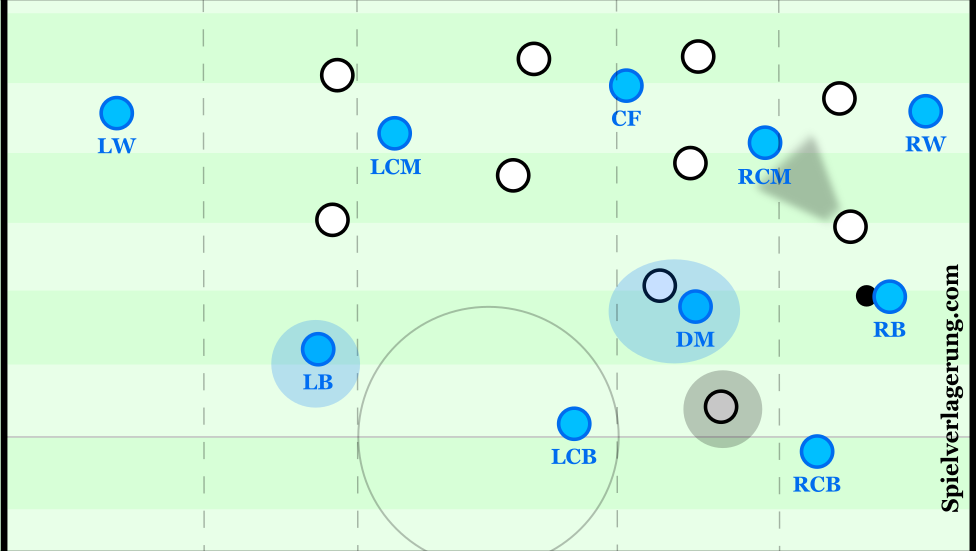

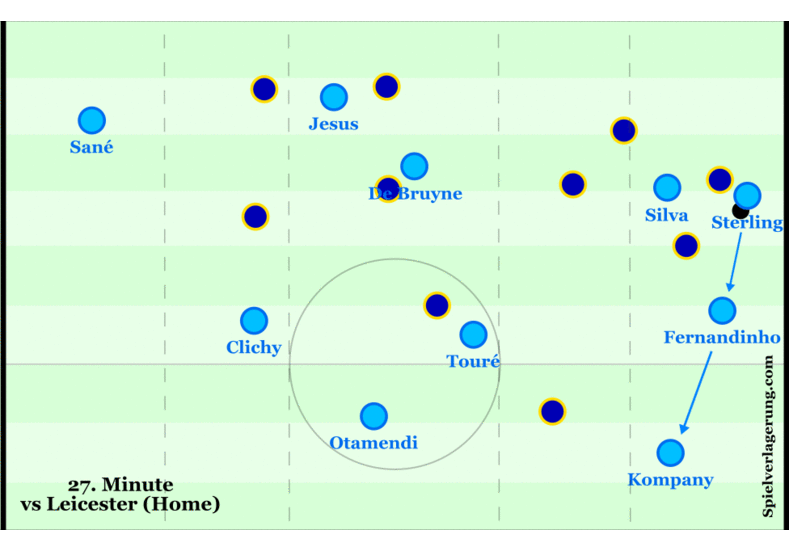
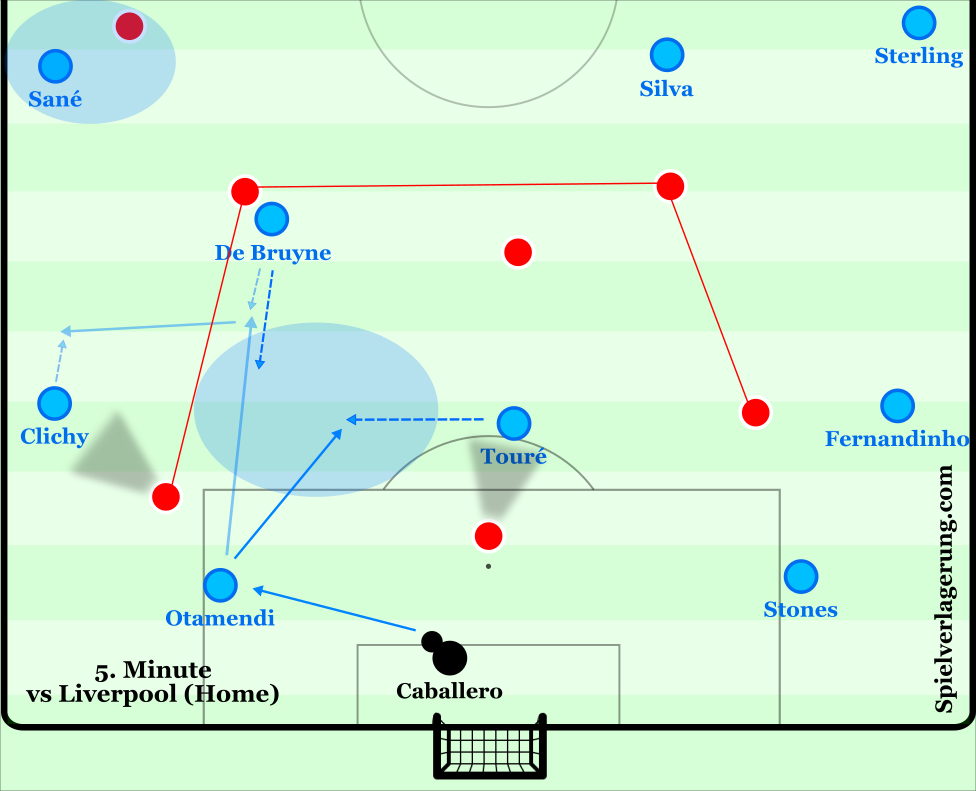
4 Kommentare Alle anzeigen
Johan Neeskens August 20, 2017 um 7:39 pm
Thanks for this analysis. It helped us understanding and implementing the ideas of positional play in our FIFA pro club (http://cruyff-academy.crayos.de), that was founded for this exact purpose so we can follow the principles of this playing model.
RRR July 5, 2017 um 10:26 pm
Ederson
Kompany, Ottamendi
Alves, Fernandinho, Kolarov
B.Silva, KDB, Silva, Sane
Jesus
What do you thing about this team ?
tobit July 6, 2017 um 9:14 pm
It lacks Gündogan. He is able to solve most of their problems in build up because his positioning, dribbling and passing are superior to the likes of Delph, Fernando or Fernandinho. Also he is far more capable of doing the defensive work than de Bruyne or the Silvas.
___________________________Jesus____________________________
__________________D.Silva________de Bruyne_________________
____Sane__________________________________________Alves____
______________Fernandinho_______Gündogan_______________
__________Stones________Kompany_____Otamendi__________
__________________________Ederson__________________________
I decided to field a 3 man defense with Alves on the “right wing” (he still plays RB in defense) to emphasize his attacking playstyle. Stones could be deployed as LB – he is pretty fast but likes to make inexplicable errors when playing as CB. In attack he could still use his ballcarrying skills from a relatively deep position alongside Kompany and Otamendi.
There are some tough decisions to make who to play in offense. Agüero, Sterling and B. Silva are too strong to stay sidelined for long but the other four seem to be a bit ahead at the moment. That could change pretty quickly depending on opponents, injuries, …
DrKlenk June 28, 2017 um 12:24 am
As expected, great analysis.
While the fullback signings (Mendy, Alves and Walker as it seems) will probably be announced soon, there have been almost no links to centre-back or dms. How do you think that would work out (going into the season with the same players in these crucial positions)?
Kompany (when fit) and Stones (with some training) are okay I guess, Fernandinho is a good dynamic number 6 and Toure can be extraordinary good on the ball, but is almost laughably lacking without it usually.
So I´m generally surprised that there are no rumors about players like Laporte, Weigl, Paredes, etc.